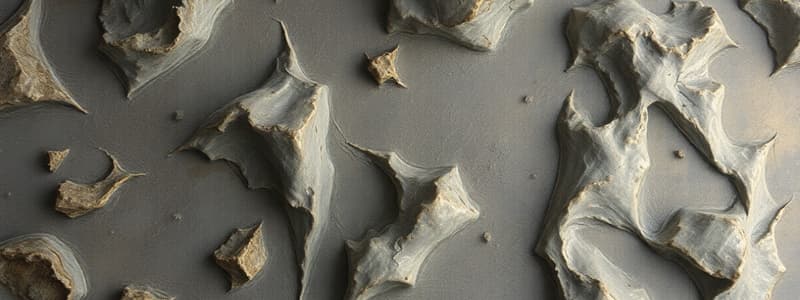Podcast
Questions and Answers
What fundamental property does SST measure?
What fundamental property does SST measure?
- Density of a solid material
- Total surface area per unit volume of a solid (correct)
- Total mass of a solid material
- Volume of voids in a solid material
Which calculation method assumes a monolayer adsorption on the surface?
Which calculation method assumes a monolayer adsorption on the surface?
- Barrett-Joyner-Halenda (BJH) method
- Mercury porosimetry
- Surface area/volume ratio estimation
- Brunauer-Emmett-Teller (BET) method (correct)
Which factor does NOT contribute to a higher Specific Surface Area (SST)?
Which factor does NOT contribute to a higher Specific Surface Area (SST)?
- Higher porosity
- Smaller particle size
- Enhanced surface area/volume ratio
- Increased particle size (correct)
What does the Barrett-Joyner-Halenda (BJH) method primarily determine?
What does the Barrett-Joyner-Halenda (BJH) method primarily determine?
What role does surface treatment play in SST?
What role does surface treatment play in SST?
In which application is high SST particularly advantageous?
In which application is high SST particularly advantageous?
Which method involves measuring pressure needed to force mercury into pores?
Which method involves measuring pressure needed to force mercury into pores?
Which material commonly benefits from high SST for adsorption purposes?
Which material commonly benefits from high SST for adsorption purposes?
Which statement accurately describes the effect of surface area in energy storage applications?
Which statement accurately describes the effect of surface area in energy storage applications?
What is a critical factor affecting the precision of SST measurements?
What is a critical factor affecting the precision of SST measurements?
What limitation is associated with methods like BET and BJH for SST measurement?
What limitation is associated with methods like BET and BJH for SST measurement?
Why is sample preparation considered critical in SST measurement?
Why is sample preparation considered critical in SST measurement?
What role does SST play in environmental applications?
What role does SST play in environmental applications?
What can be a consequence of using an inappropriate measurement technique on a complex shaped material?
What can be a consequence of using an inappropriate measurement technique on a complex shaped material?
Which of the following statements is true regarding the interpretation of SST measurements?
Which of the following statements is true regarding the interpretation of SST measurements?
What is the significance of understanding SST in material science?
What is the significance of understanding SST in material science?
Flashcards
Specific Surface Area (SST)
Specific Surface Area (SST)
A measure of the total surface area of a solid material per unit of its volume.
BET Method
BET Method
A method for measuring SST based on gas adsorption at low pressures. It assumes a monolayer adsorption on the material's surface.
Mercury Porosimetry
Mercury Porosimetry
This method uses mercury intrusion to determine the pore size distribution of porous materials, enabling SST calculation.
High SST materials
High SST materials
Signup and view all the flashcards
Particle size and SST
Particle size and SST
Signup and view all the flashcards
Porosity and SST
Porosity and SST
Signup and view all the flashcards
Surface treatments and SST
Surface treatments and SST
Signup and view all the flashcards
SST in Catalysis
SST in Catalysis
Signup and view all the flashcards
What is Specific Surface Area (SSA)?
What is Specific Surface Area (SSA)?
Signup and view all the flashcards
Why is SSA important?
Why is SSA important?
Signup and view all the flashcards
How does SSA impact material applications?
How does SSA impact material applications?
Signup and view all the flashcards
How does SSA affect energy storage devices?
How does SSA affect energy storage devices?
Signup and view all the flashcards
How does SSA influence environmental applications?
How does SSA influence environmental applications?
Signup and view all the flashcards
Why are accurate SSA measurements important?
Why are accurate SSA measurements important?
Signup and view all the flashcards
What are the limitations of SSA measurements?
What are the limitations of SSA measurements?
Signup and view all the flashcards
What are the considerations in choosing an SSA measurement technique?
What are the considerations in choosing an SSA measurement technique?
Signup and view all the flashcards
Study Notes
Introduction
- SST stands for Specific Surface Area of a solid.
- It's a measure of the total surface area of a solid material per unit of its volume.
- This is a crucial property in various fields, including catalysis, adsorption, and material science.
- SST is often expressed in units like m²/g.
Calculation Methods
- Calculating SST involves different techniques based on the material's structure and properties.
- Common methods include:
- Brunauer-Emmett-Teller (BET) method: This method is based on the adsorption of gases onto the surface of the material, specifically at low pressures. The key is to determine the amount of gas adsorbed at different pressures. The method assumes monolayer adsorption on the surface and is applicable to porous materials.
- Barrett-Joyner-Halenda (BJH) method: Used to determine the pore size distribution of porous materials by analyzing adsorption isotherms. This uses the Kelvin equation to determine the pore size based on the degree of capillary condensation.
- Mercury porosimetry: This method uses mercury intrusion to determine pore size (and thus SST) of porous materials. Mercury fills the pores. The pressure needed to force the mercury into the pores is measured and used to interpret pore size and volume.
Factors Affecting SST
- Particle size distribution: Smaller particles have a higher SST compared to larger particles of the same material, assuming similar overall mass.
- Porosity: Highly porous materials have higher SST due to extensive surface area within the void spaces.
- Surface area/volume ratio: Smaller particles or highly porous materials exhibit a greater surface area to volume ratio, leading to higher SST.
- Material structure and morphology: Crystal structure and the presence of defects can influence a material's surface area.
- Surface treatments: Surface treatments (like oxidation or chemical modifications) can alter the surface area, significantly if increasing surface roughness.
Applications of SST
- Catalysis: High SST materials are desirable catalysts because they provide a vast surface area for reactant interactions, enhancing reaction rates and efficiency.
- Adsorption: Materials like activated charcoal and silica gel, with high SST, are excellent adsorbents for gases and liquids.
- Material science: Understanding SST is key in characterizing materials for various applications, including filters, pigments, fillers, and supports in composite materials, where increased interaction area improves performance.
- Energy storage: Higher SST can enhance battery capacity by improving electrochemical reaction rates at the electrode/electrolyte boundary.
- Environmental applications: SST is crucial for contaminant removal in environmental applications, enabling increased interaction between the contaminant and the material.
Importance of Accurate SST Measurements
- Precise SST measurement is crucial for understanding material behavior and performance in various applications.
- Accurate measurements enable researchers and engineers to optimize materials for their intended use.
- Variations in measurement techniques can lead to slight differences in calculated SST. The right method, considering the material and desired information, is essential.
- Using the appropriate technique prevents errors and misinterpretations in results.
Limitations of SST Measurements
- Methods like BET, BJH, and mercury porosimetry may not completely represent the precise surface area under study and have limitations regarding accuracy.
- Some methods are not suitable for all materials. It's critical to choose the correct method for a given material.
- Measurement techniques can present challenges for materials with complex shapes, multiple layers, or microscale variations.
- Interpreting SST for non-porous materials can be difficult.
- Sample preparation is vital; incorrect handling can lead to flawed or misleading readings. The preparation method (e.g., drying, grinding, compression) must be compatible with the material's properties.
Conclusion
- SST is a significant material property affecting performance in numerous applications.
- Understanding factors affecting SST and using suitable measurement techniques is essential for optimizing materials for specific tasks.
Studying That Suits You
Use AI to generate personalized quizzes and flashcards to suit your learning preferences.




